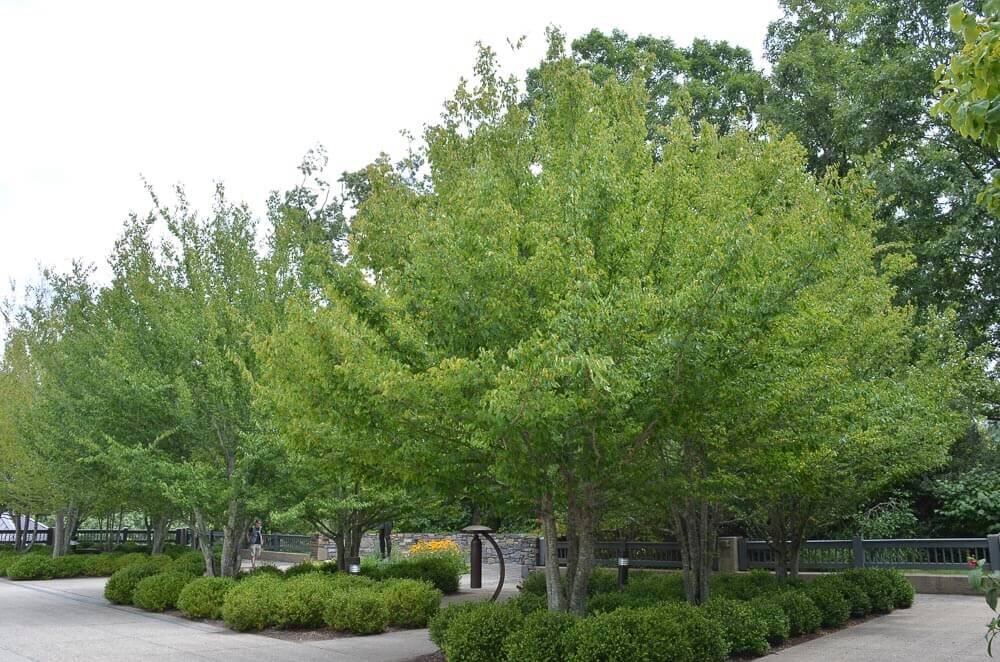Sinewy bark typical of musclewood
A Tree With Many Aliases
Carpinus caroliniana goes by many names: musclewood, American hornbeam, water beech, blue beech, and ironwood (not to be confused with a different ironwood that we also offer). When you’re strolling through Wisconsin woodlands and you come upon this tree, the name most likely to come to mind is “musclewood” because the smooth, ridged trunk resembles the musculature of a sinewy action movie hero. Here at Heartwood, we usually use “musclewood” as it avoids the confusion other names can cause. “Blue beech,” for example, is a misleading name, since this tree is not a beech at all, and is in fact in the birch or hazelnut family (depending which botanist you ask).
Attractive Qualities of Musclewood Trees
Musclewood takes a roughly rounded shape, growing slowly to a maximum size of about 30 feet tall and 20 feet wide. It’s a great choice for small spaces, and its shade tolerance makes it successful in filling spaces beneath larger trees. In spring, its slim catkins and leaves appear simultaneously, and soon the catkins give way to nutlets. Many birds feed on the nutlets, buds, and catkins, including wood duck, ruffed grouse, bobwhite, and yellow-rumped warbler. Gray squirrels and fox squirrels also feed on the tree, and beavers use it for both food and construction. But rest assured, a beaver will not likely abscond with your musclewood here in the Madison area. Due to its dense branching and copious foliage, musclewood trees make excellent screens throughout the growing season. In autumn, the leaves turn scarlet orange. After dropping its leaves, musclewood’s unique branch shapes provide excellent winter interest.
Group of musclewood trees in a formal garden
Incredibly Hard, Useful Wood
The muscular look of the musclewood tree is matched by the strength of its wood. Its common name “hornbeam” is a reference to its unusual strength, with “horn” denoting the horn-like toughness of its wood and “beam” being an Old English word for tree. Because this tree very rarely reaches sawlog size, it is seldom seen or treated as lumber. Although not typically available commercially, it has been used by settlers since the early colonial times, when William Wood, in his 1634 book New England’s Prospect, described British America to potential colonists. He wrote of musclewood: “the Horne-bound tree is a tough kind of Wood, that requires so much paines in riving as is almost incredible, being the best to make bolles and dishes, not subject to cracke or leake.” Indeed, in addition to being used for bowls, settlers used the tough, dense wood for ox yokes, levers, and wedges. To this day, it remains a popular choice (for those who can find it) for crafting handles of striking implements like axes and mallets.
First Peoples Uses of Musclewood
Long before the arrival of European colonists, the Ojibwe people, who live in what is now the upper Midwest and Canada, used musclewood as a construction material, most commonly as ridgepoles in wigwams. Decoctions of its bark have been used in Cherokee, Iroquois, and Delaware medicine to treat painful urination, “diseases peculiar to women,” and diarrhea, respectively. In Cherokee medicine it also is compounded with other medicinal plants to treat cloudy urine and dysentery.
Catkins from the Firespire variety of Musclewood
Musclewood in Wisconsin Forest Communities
Musclewood is found in a wide range of forest cover types, including forests where sugar maple, white oak, northern red oak, American beech, and black cherry are dominant. If you’re searching for one in the forests of Wisconsin, look near lakes, swamps, rivers, or ravine bottoms. But despite thriving in damp, shady locations, musclewood is highly adaptable, growing well in drier soils and in full sun.
Musclewood nutlet
Considering Musclewood for Your Property
We plant these exclusively as bare root trees, and they transplant extremely well this way. If you’re planning to use musclewood in a naturalistic planting, or in an ecological restoration project, there are many companion species that muslcewood grows alongside in Wisconsin’s forests. Larger shrubs and small trees suitable for companion planting include ironwood (also known as eastern hophornbeam), flowering dogwood, witch-hazel, serviceberries, and speckled alder. For smaller shrubs, spicebush, arrowwood viburnum, mapleleaf viburnum, and pagoda dogwood all commonly cohabitate with musclewood. We often have many of these shrubs and small trees for sale either through our online store or through special order. Just ask!




